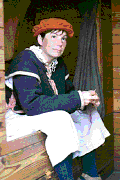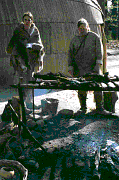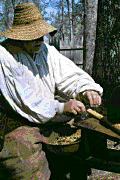In 1607, some 13 years before the voyage of the Mayflower, an expedition sponsored by the Virginia Company of London established the first permanent English settlement in America.
The colony was located on the north bank of the James river estuary, and was named Jamestown, in honour king James the First. From the first the settlement seemed doomed to failure through bad planning. The original group of 104, all men and boys, were chosen from 'gentlemen' investors, unsuitable tradesmen and unskilled urban poor. They arrived ill equipped and unprepared for the rigours of life required to establish the settlement.With not a farmer amongst them, and with ongoing hostilities with the native Powhatan Indians, starvation was a constant in the early years. Even with the iron rule of Capt. John Smith, who established a 'no work - no food' policy, only 35 were to survive the first winter. The Virginia company, thinking only of profits, continued to send inadequate supplies of food, and colonists such as goldsmiths and glass blowers. Despite the disastrous "Starving Time" in 1609/10, when 330 of 390 died, the colony endured. Eventually the introduction of tobacco as a cash crop that ensured the life of the settlement. Jamestown was to remain the primary community in Virginia until the decision to move the state capital to Williamsburg in the early 1700's.
The Jamestown Settlement is a recreation of how the colony looked in the early years, about 1615. It consists of the James Fort, a Powhatan Indian village, reproductions of three of the ships that served the colony and a museum gallery complex. The historical section is tucked into a forest of oaks, and is staffed by costumed interpreters. The museum complex was established in 1957 to mark the 350 the anniversary of the founding, making it one of the oldest living history museums in the USA. The whole site has an English, rather than American, feel to it. With much experience at museums, we arrived early, saw the orientation program, skipped visiting the gallery until latter and went straight to the site. It was a weekday, early in the season, which meant few other tourists, BUT roving packs of school tours. (As a bit of advice - the best time to visit any museum is the first two weeks in September - after summer holidays, but before school trips start.) The introductory 20 minute film is well crafted, entertaining, accurate and informing. Unlike may of such presentations, it has a realistic feel to it, and surprising for an American museum, does not 'wave the flag'. It is told as a fireside remembrance of one of the original colonists. The presentation touches on the social climate in England at the time of the settlement. It sketches the development of the colony over its first 20 years or so. In so much as I am unfamiliar with the period, I was glad we saw it first. |
|
| The James fort itself has an amazingly 'real' feel to it. Because the site is 40 years old, the main structures and many of the artifacts have been in use that long. This gives the site a wonderful mixture of worn and new - much like it would have been in the 1600's. Part of what gives this museum its unique flavour is the architectural style, which is purely from the English late middle ages. The houses are all timber frame with wattle and daub walls and thatch roofs. The construction is of local timber, clay and reeds. As weather and age takes its toll, sections of the mud covering are allowed to fall away, with the constant repairs made part of daily interpretation. This contrasts with the two other styles of historic recreation often seen - everything reproduction and new, or everything original and worn out. The staff is also able to be more casual about the handling of artifacts, kicking buckets out of the way, and not watching over your shoulder to keep you from touching things. There is an lot of trouble taken with fine details. For example - the restricted use of cast iron (correct for the period - but only an 'expert' would know that), most of the cooking vessels where hammered sheet. Most of the timber used is oak - and from oak trees like you'll never see in Canada! The forest surrounding the site are second growth trees one and half foot in diameter that run dead straight 25 feet before the first branch comes off. This timber is what makes up the site - boards split with a froe with no knots and dead even for 20 feet or more! A simple thing, but something that really hit home the difference in both time and geography to me. |
|
Because the staff didn't have to worry so much about the security of the artifacts, they were mainly stationed about the open area of the fort complex. I found them to be very knowledgeable about their period, and always willing to admit what they did not know. In each case this happened (we always end up asking some pretty obscure questions), the staff member referred us to who else would be best able to answer. In two cases we had someone dragged off to find us latter to supply information. After asking a technical question in the historic area, we had someone come to find us in the gallery, over and hour latter. The fellow was just off work, and had come looking for us on his own time! Needless to say I was very impressed. Only one of the ships, the Susan Constant, which is largest of the three, was open to the public the day we were there. All of the ships are working vessels, and are actually taken out under sail on the weekends. In contrast to the realistic grime of the fort, I found below decks a bit too clean and tidy. (This is nit-picking, safety and traffic flow demands this.) Again I found the staff willing to discuss not only individual items and their implications, but how the artifacts were being interpreted. |
|
I found that the presentation of the Powhatan village did not work as well as the other two areas. This was mainly because there were only two interpreters stationed here, both at outside tasks, somewhat removed from the buildings. This seemed to make the houses themselves more like static exhibits with no explanation. To be fair, it was about lunch time, and I'm sure if there was a question concerning a building the staff would have gone over to answer it. Another slight problem here was how obviously 'white' the staff representing the Native people where. They were quite sensitive to this issue, and apparently the museum works quite closely with the local tribal council to ensure accuracy in the presentation. One thing I did like was the way this area was dressed with 'garbage', tossed piles of bones, broken pots, corn cobs, etc. The interpretive style used in the complex is third person - "They did this...". I felt that considering the detail of artifact and costuming, that the use of a first person point of view would have worked better. Sometimes the modern references in conversations were a bit jarring. As well the staff were using an approach that directed them to stop working when talking. With a lot of visitors to the site, this meant a lot of talk and very little physical demonstration. Both of these interpretive techniques are somewhat set by the requirements of the average visitor to any site, which in the USA have to be very generous. |
|
In general, I would say that Jamestown Settlement is a historic site well worth visiting. The physical presentation, especially in the James Fort, has a very realistic feel to it. The staff is well trained and extremely helpful. Although it is clearly an American location, it offers clear insights into the culture of England in the early 1600's. Jamestown Settlement is located 12 miles south of Williamsburg Virginia, just off route 31. The site is open 9 to 5 daily, year round.  |
|





